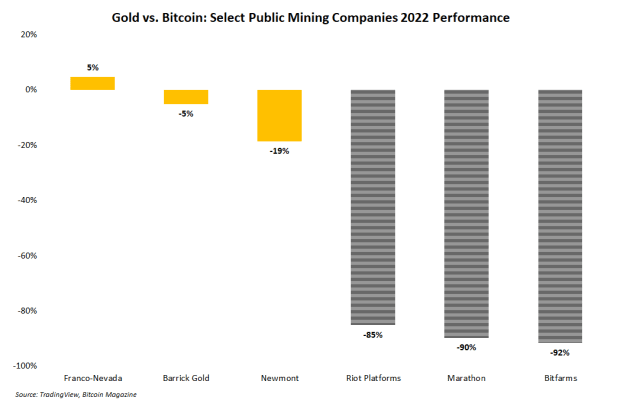Digital gold mining companies suffered harsher drawdowns than their legacy counterparts in 2022.
Bitcoin’s prominent memetic narrative as “digital gold” begs a comparison to the real yellow metal. But since the advent of Bitcoin, comparative perspectives of the mining sectors underlying both assets are too often missing.
In May 2022, this author published data on the gold/bitcoin mining contrast as digital gold producers were significantly underperforming ore miners. Now, the time seems right to provide a follow-up overview of some recent market data for bitcoin and gold miners.
The past year of unpredictable economic tumult and bear market financial brutality have highlighted a few important idiosyncrasies between gold and its blockchain-based counterpart. In the following paragraphs, data will underscore similarities and differences between the two “mining” industries. In ways that aren’t often revealed by Twitter banter, miners of gold and bitcoin have plenty in common.
Inside Bitcoin And Gold Mining Market Data
Bitcoin bulls should sit down before continuing to read this section. Peter Schiff will be euphoric.
2022 wasn’t an easy year for anybody, but bitcoin miners suffered especially-difficult market conditions. Compared to bitcoin miners, gold mining stocks had a fairly easy year. A select group of public gold and bitcoin mining companies are represented in the bar chart below. Percentage-based yearly performances from 2022 for all companies are visualized in the chart.

Measured in percentage drops from all-time highs, gold wins again. (Go ahead and laugh, Schiff.) At the time of writing, gold is roughly 7% off its record high — nearly the same price as in May when this author last wrote about gold and bitcoin miners. Meanwhile, digital gold is trading more than 65% lower than its high point, reached in late 2021.
But bitcoin being outperformed by gold isn’t the historical norm. Throughout 2021, bitcoin and its mining companies enjoyed a strong and prolonged uptrend. Gold and gold miners lagged significantly over the same period.
And the honey badger should never be counted out.
Bear Market Mining Brutality
Regardless of how gold miners performed, the past year was arguably the most difficult bear market period in Bitcoin’s history. So, underperforming gold (or any other asset) is hardly a surprise.
The following is a brief synopsis of what bitcoin miners survived last year that led to, among other things, underperforming yellow-metal-ore miners.
For public mining companies, potential delisting notices from stock exchanges were all too common. In August 2022, BIT Mining received a notice from the New York Stock Exchange (NYSE) about potential delisting due to minimum price standards. The same month, Mawson received a notice of potential delisting for the same reason. In October 2022, Digithost received the same notice of potential delisting, as reported by The Block. Greenidge Generation received a notice of potential delisting in the middle of December 2022. Bitfarms received a similar notice one day after Greenidge for the same reasons. And Canaan, a Nasdaq-listed mining hardware manufacturer, also received notice of potential delisting because it used an auditor whose work can’t be inspected by the U.S. audit regulator.
Mining executives also left in droves — voluntarily or otherwise. Dave Perrill, former CEO of Compute North, resigned in September 2022. Jeffrey Kirt, who led Greenidge Generation since 2021, abruptly resigned in early October 2022. Whitney Gibbs, who co-founded Compass Mining, also abruptly resigned amid “setbacks and disappointments” in July 2022. Emiliano Grodzki, who co-founded Bitfarms in 2017, announced his resignation three days before the end of 2022.
Mining bankruptcies made headlines every month last year. Compute North filed for bankruptcy in September 2022. Seven months before bankruptcy, the company raised $385 million. Core Scientific, the largest publicly-traded bitcoin mining company, also filed for bankruptcy a few days before Christmas. Celsius, a prominent crypto lending platform, also saw its sizable mining unit go bankrupt just months after the team announced its plans to go public. BlockFi was another prominent crypto lending service that maintained a sizable mining unit and has filed for bankruptcy. Bloomberg reported that Marathon disclosed over $80 million of exposure to now-bankrupted Compute North. Argo accidentally posted fully-prepared bankruptcy filings on its website before a $100 million deal with Galaxy Digital’s mining team helped Argo avoid “real” bankruptcy.
And lots of mining lawsuits were filed. Blockware was sued. Iris Energy faced a class-action lawsuit. Tennessee’s Washington County sued BrightRidge, a local mining utility. Riot sued Northern Data. Whinstone, Riot’s flagship mining subsidiary, counter-sued Japan’s CMO Internet in a four-year ongoing dispute. And Core Scientific was sued.
Suffice to say, whichever mining teams survived the past year are likely to survive anything.
Darkest Before The Dawn?
Given the market conditions in the bitcoin mining sector last year, it would be a shock to any investor if bitcoin miners outperformed their gold counterparts. But does one year of underperformance affect Bitcoin’s long-term potential? Clearly not. The utility of this comparison only serves as additional context for the ongoing expectation that digital gold will gradually but steadily absorb the market capitalization of physical gold.
Bitcoin is as volatile as it is valuable, however. Even in January, bitcoin mining companies are roaring back as the price of bitcoin itself rallies. Now all miners are hoping last year was the “darkest” and soon will be the “dawn.”
This is a guest post by Zack Voell. Opinions expressed are entirely their own and do not necessarily reflect those of BTC Inc or Bitcoin Magazine.
Source: Bitcoin Magazine - Bitcoin News, Articles and Expert Insights
#Business, #BitcoinMining, #Gold, #PublicMiners, #BearMarket, #Feature